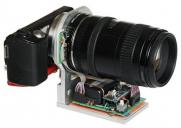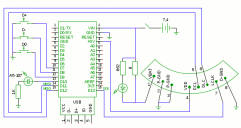
It allows to keep PV going, with more focus towards AI, but keeping be one of the few truly independent places.
-
This comes from:
http://diydrones.com/profiles/blogs/arduino-control-of-a-camera-lens
Vladimir-- built an Arduino-based pass-through ring (translated) which intercepts automatic lens controls. It’s meant for use with the Canon EOS lenses which have their own electronics allowing control of things like focus and zoom.
It seems like part of the motivation here was to uses the lenses with other brands of cameras. But Vladimir does also talk about the possibility of improving on some of the sensors that don’t perform well in certain climate conditions (think of how crystal oscillators will drift as temperature changes).
The machine translation is a bit rough to follow, but it seems the adapter ring still uses the settings sent in from the camera but has the Arduino clone to translate them into a format that the lens is expecting. In addition to this there is a set of buttons on that small PCB beside the lens which allow for fine tuning the aperture.
Here is the Russian link if anyone can translate or extract better info:
http://www.ixbt.com/digimage/canonautosonyl.shtml
It would be nice to translate GH-2 lens focus commands to say Canon. Then we can have our autofocus and aperture control on a wide range of adapted lenses.
Maybe a Russian speaker can e-mail him to see if he can adapt to M43 to canon rather than Sony to Canon.

 microcontrollercomandeerscameralensfunctione1330107557835.jpg470 x 332 - 33K
microcontrollercomandeerscameralensfunctione1330107557835.jpg470 x 332 - 33K
 IMG_3593am.JPG580 x 859 - 99K
IMG_3593am.JPG580 x 859 - 99K
 IMG_3579ar.JPG525 x 756 - 192K
IMG_3579ar.JPG525 x 756 - 192K
 canonautos3ai.png580 x 308 - 11K
canonautos3ai.png580 x 308 - 11K -
Nice, but all I see is aperture control thru arduino... so no Zoom, focus or IS.... and not controlled directly from camera, but from the microswitches.
But anyway, nice
-
Incorrect. It is a translator. Camera sends signal focus out, arduino converts that to Canon signal focus out. Lens sends signal it is at 70mm lens, arduino translates that to M43 signal to camera.
-
Well, if I look at the backside of the adapter, I don't see any contacts to the camera - do you? And the microswitches 3,4 are mentioned on the page as "aperture open, close"
Anyway, I don't see any translator here, just a controller
-
I’m sorry to disappoint you, @disneytoy, but that’s not a translator. The device only controls the aperture of some EOS lenses.
-
I read " the adapter ring still uses the settings sent in from the camera but has the Arduino clone to translate them into a format that the lens is expecting. In addition to this there is a set of buttons on that small PCB beside the lens which allow for fine tuning the aperture."
Maybe Vitaliy or someone who reads Russian can read the original page and report back.
-
This guy is known for making low quality and hard to explain DIY things.
He openly states that this thing burned few lenses and is working very problematic with most others.Anyway, it can be interesting info, but only for really die hard fans.
-
Thanks Vitaliy for checking it out. I still think with an arduino, you could find the commands coming from the GH-2 to the lens (aperture, focus in and out) and translate them into Canon lens.
You just have to learn the commands being sent. I don't think M43 specs are in the public for lens communication. Obviously, with RED and the other Canon adapters the proper commands have been extracted.
-
Thing that you want to do require work of 3-10 engineers for few months. may be more, looking at the others similar adapters.
Thing described in this article is DIY in its worse - very hard and time consuming to reproduce and badly working. -
I read “the adapter ring still uses the settings sent in from the camera but has the Arduino clone to translate them into a format that the lens is expecting.”
Sorry, I’m not seeing that in the Russian. I guess both Hack a Day’s and DIY Drones’s wishful thinking and Google’s (I assume) machine translation got the better of them.
-
Interesting concept and in theory it would work but I don't think its as simple as it seems on the surface. Also that adapter thing has no contacts on the m4/3 side of the mount as mentioned above so it can't be a translator type device. It would be interesting to see how AF would perform with such an adapter too.
-
RED has spent quite a bit of engineering time on making their Canon adapter (more than a year!). It's great, better than Canon, actually. But it costs 500,- U$ in Au and 2.000 in Ti.
Howdy, Stranger!
It looks like you're new here. If you want to get involved, click one of these buttons!
Categories
- Topics List23,992
- Blog5,725
- General and News1,354
- Hacks and Patches1,153
- ↳ Top Settings33
- ↳ Beginners256
- ↳ Archives402
- ↳ Hacks News and Development56
- Cameras2,367
- ↳ Panasonic995
- ↳ Canon118
- ↳ Sony156
- ↳ Nikon96
- ↳ Pentax and Samsung70
- ↳ Olympus and Fujifilm101
- ↳ Compacts and Camcorders300
- ↳ Smartphones for video97
- ↳ Pro Video Cameras191
- ↳ BlackMagic and other raw cameras116
- Skill1,960
- ↳ Business and distribution66
- ↳ Preparation, scripts and legal38
- ↳ Art149
- ↳ Import, Convert, Exporting291
- ↳ Editors191
- ↳ Effects and stunts115
- ↳ Color grading197
- ↳ Sound and Music280
- ↳ Lighting96
- ↳ Software and storage tips266
- Gear5,420
- ↳ Filters, Adapters, Matte boxes344
- ↳ Lenses1,582
- ↳ Follow focus and gears93
- ↳ Sound499
- ↳ Lighting gear314
- ↳ Camera movement230
- ↳ Gimbals and copters302
- ↳ Rigs and related stuff273
- ↳ Power solutions83
- ↳ Monitors and viewfinders340
- ↳ Tripods and fluid heads139
- ↳ Storage286
- ↳ Computers and studio gear560
- ↳ VR and 3D248
- Showcase1,859
- Marketplace2,834
- Offtopic1,320





